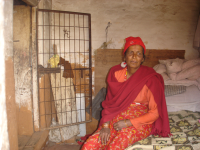MADAGASCAR: On the slippery slope to hunger
Mothers and children were at the frontline when malnutrition met weakened immune systems Zafy said, and "at this point the problem is becoming critical". She started screening children in mid-March and by the end of April had already identified some 90 severely malnourished under-fives. "It's been getting worse and worse for a while now," she commented.
Besides a chronic lack of water, the south also suffers from a shortage of health staff and treatment supplies. some 15,000 Malagasy in the Sampona area depend on Zafy's centre and she runs it pretty much on her own, a situation not uncommon in the region.
With the chances of good rain in the south of the huge Indian Ocean Island highly unlikely, she has little reason to believe things will get better anytime soon. "There are already so many cases that it is difficult to cope," she said, opening the clinic door to some 30 mothers and many more children waiting for screening and treatment that day.
Worried mothers of hungry children
"I am afraid for my children now because I can't feed them," Siza Matavy, who had brought her children for screening and was first in the queue, told IRIN. One child was already on a treatment called Plumpy'nut, a high-protein, high-energy, peanut-based paste provided to health and nutrition centres by the UN Children's Fund (UNICEF), and she hoped the other two might benefit too.
"We don't have much land that we can [cultivate]," Matavy said. Poor rains and more mouths to feed as her family expanded over the past years meant constant hunger, increasing under-nutrition, and rising worry over about the future.
Sazy, 22, a single mother of three who had just walked seven kilometres to bring her children to the clinic, was next. Visibly emaciated, her 12-month-old daughter was referred to a hospital for admission and free treatment, "But it is impossible for me to go," she said.
Although transport for the 25km ride to the hospital would probably not cost more than the equivalent of US$1, and the hospital would reimburse her, she simply did not have the money to pay in the first place, and also could not leave her other two children unattended. Sazy's desperation is echoed across southern Madagascar. At a health centre in Ifotaka, also in the Anosy region, another worried mother, Sitrapoe, told IRIN she had sold her family's last asset, a goat, in December 2008 and now had nothing left. Her nine-month-old daughter was screened and found to be severely malnourished.
Running on empty
This depletion of wealth - no more than a wafer-thin buffer against abject poverty to begin with - and deepening vulnerability was common in the drought-affected south and, more so now than in previous years, was a major concern, said Zo Roabijaona, Director of the government's Early Warning System (SAP) in the region of Androy.
"Lack of rain is at the heart of the problem ... [but] the drought used to occur every 10 years, then every five; now we have drought every year," he said. In the past, communities had managed to build up resilience and had been able to cope with an occasional bad harvest, but three consecutive years of poor rain meant their assets were gradually being sold off to feed families and had by now been depleted. By December 2008 SAP had sounded the alarm, warning that some 400,000 people were living in food-insecure districts, so this was by no means a sudden surge, Roabijaona said - the problem had become chronic. What UNICEF had called a "silent emergency" - the nutrition crisis - had lingered, and had become progressively worse for some time now.
A nutrition survey in April by the Ministry of Health, the National Nutrition Office and UNICEF, in five districts of the Anosy and Androy regions, indicated that global acute malnutrition rates in children under the age of five had reached "serious" levels and were edging towards "critical". According to UNICEF, over 100 health facilities were equipped to treat severely malnourished children, but with Madagascar's resources overstretched, its health services overwhelmed and the numbers of malnourished children climbing, this was not enough. "Additional financial resources are absolutely critical for us to be able to address the threat that the current drought poses to the survival of children," said Bruno Maes, the UNICEF Representative in Madagascar.
Alarm over the worsening drought, the aftermath of two recent cyclones that brought widespread damage and flooding, and the ongoing political turmoil, prompted the humanitarian community in Madagascar to make a joint "Flash Appeal" for $36 million on 7 April, but barely $1 million in commitments has been made to date.
tdm/he© IRIN. All rights reserved. More humanitarian news and analysis: http://www.irinnews.org/









